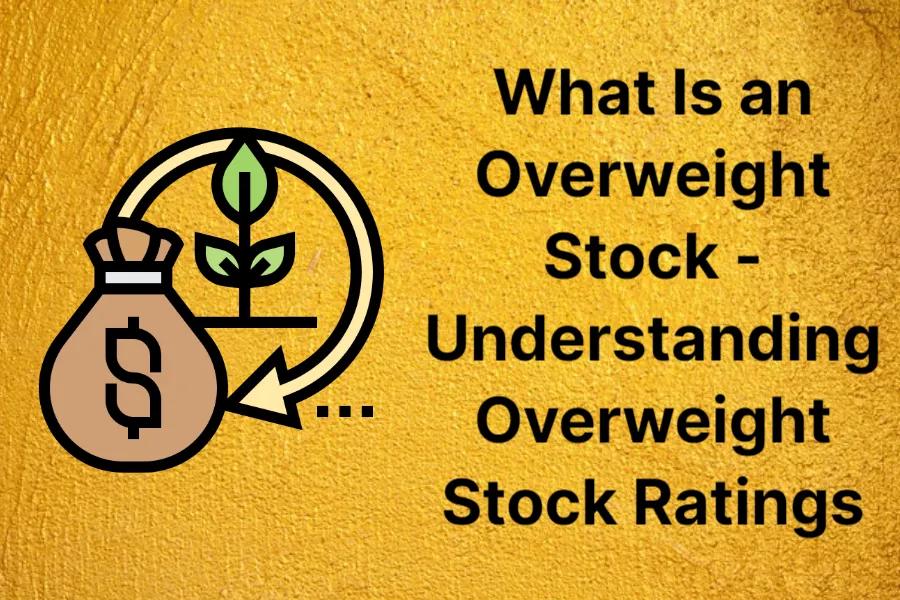If you’ve ever read a report from an investment analyst, you may have seen stocks described as “overweight.” It can be a difficult term to understand. Most people are used to seeing more straightforward “buy” or “sell” ratings.
A stock that is overweight is one that analysts predict will perform better than a benchmark stock, asset, or index. An analyst who gives an overweight recommendation thinks the stock will perform well over the following year.
Where Does This Weighting System Come From?

Overweight stocks: what are they? It’s crucial to understand that label in order to ensure that the index accurately reflects the performance of that market sector. Market indices weight the investments they monitor.
For instance, the S&P 500 tracks 500 large-cap U.S. companies. Market capitalization determines how much each of the index’s companies, or constituents, is worth. The market capitalization of a company is calculated by dividing the share price at the moment by the total number of outstanding shares. Based on how much of the index’s market capitalization each company contributes, companies are weighted in that index.
Different weighting schemes may be employed by other indices. For instance, the Dow Jones Industrial Average tracks 30 blue-chip companies and weighs them according to stock price. More weight is given to companies with higher share prices than to those with lower prices.
It’s crucial to understand that an overweight to a particular stock with respect to one index may not be the same with respect to another due to these various weighting systems.
Overweight Stocks
So it’s generally a good sign when an analyst rates Stock X as overweight. First, they contend that, depending on the state of the market, Stock X may outperform its benchmark index or even the market as a whole, and advise investors to consider holding more of the stock.
Bear in mind that an “overweight stock” rating doesn’t necessarily mean that stock is a juggernaut. Being overweight in a bear market simply means that the company may not lose as much ground or may grow more slowly than its competitors.
Underweight Stocks
When a stock is given an underweight rating by an analyst, it means that the analyst expects the stock to underperform its benchmark and advises investors to hold less of the stock.
Equal Weight Stocks
When a stock receives an equal weight rating from an analyst, it simply means that the stock is in line with the overall benchmark.
Again, it’s critical to keep in mind the market’s broader context and what these ratings mean to analysts when thinking about these ratings.
Why the Reference to Weight is Used
You may hear “overweight” used in a different context, often relating to the makeup of an investment portfolio.
Typically, a diverse mix of stocks and other investments should make up your portfolio. Try to stay away from putting all of your eggs in one basket. When you have a good mix like this, it means that your portfolio is properly “balanced.”
An unbalanced portfolio may indicate that you have an excessive amount of money invested in one sector. This is also known as being “overweight.” And if you don’t have enough of a certain investment in your portfolio, you are considered “underweight.”
What does this have to do with analyst ratings, then? Remember that market capitalization is the basis upon which stock market indices like the S&P 500 are built. Each stock gets a certain amount of “weight” in the index. Thus, Apple, for example, had a weighting of 5.70% in the S&P 500 in May 2021. This is because it is one of the world’s largest companies.2
If an analyst provides an “overweight” rating on a stock, they are saying that the company should soon receive a higher “weight” in any index it is a part of.
But the average person won’t find any of this particularly helpful. For most of us, it’s best to view an “overweight” rating as simply another way of talking positively about a stock.

Ratings Are Just Guides
Numerous people will offer their opinions on whether a stock is a wise investment for each individual stock. Ratings are merely one component of the informational puzzle, which also includes past price performance, earnings reports, profit margin, and other details.
A stock should never be bought or sold based solely on the opinion of one person. And the fact that analysts frequently disagree makes this particularly true. Thus, trying to figure out what an analyst truly means by any rating, whether “overweight” or something else, is not very useful.
What is An Overweight Portfolio?
An overweight portfolio is one that contains more of a stock or other investments than it should, according to theory. This may result in an individual investor’s portfolio being allocated to stocks to a greater extent than intended.
Say, for instance, that an investor has a portfolio allocation where 70% of it is invested in stocks and 30% in bonds. The percentage of the portfolio held in stocks could rise above 70% if the stock market increases. At that point, the portfolio may be said to be overweight in stocks, and an investor may want to rebalance to bring it in line with their original allocation plan.
Unsurprisingly, an underweight allocation is the opposite of an overweight allocation. For instance, the portfolio above would be considered underweight in stocks if the stock allocation was below 70%.
The phrase can also be used in a more specific sense. A stock portfolio might contain excessive amounts of stock in one particular business, industry, or area, for instance. Each time, the holding could be considered overweight.
Overweight is a term used by professional fund managers to describe portfolios they manage that are out of sync with their index, including mutual funds, exchange-traded funds, and index funds. By holding more or less of an investment that the index tracks, a fund occasionally risks diverging from its benchmark index.
Let’s take the case of an index fund that tracks the S&P 500. Typically, fund managers make an effort to hold each stock in the index in order to follow the index. They will also make an effort to match the percentage of each company that their fund owns to the index. Therefore, the fund will own 5% of stock A if stock A makes up 5% of the original index.
In terms of how far they can deviate from the index, some funds have a little leeway. Depending on whether they believe the stocks will perform better or worse, some may be permitted to hold more or fewer shares. The managers take an overweight position when they hold more than the index. The managers take an underweight position when they hold less than the index.
How Can Investors Interpret Overweight Stocks?

Investors considering the overweight recommendations of stock analysts may want to think carefully about whether those recommendations fit with their financial plan. If so, is the investor’s time horizon the same as the basis for the overweight recommendation? A longer-term investor might not want to follow a recommendation from an analyst if it is based on the next six to twelve months. Additionally, does the advice align with the investor’s objectives? An investor who steers clear of petroleum stocks might not act on a recommendation to buy more oil companies than usual.
Furthermore, it’s crucial to understand that an overweight recommendation is essentially a recommendation against diversification, which can be one way to help shield a portfolio from market risk. Buying an overweight security while avoiding becoming overweight in that area may be something an investor who places a high priority on diversification in their portfolio should think about.
The Takeaway
In general, it may be advantageous when an analyst assigns an overweight rating to a stock. Investors might want to buy that stock if the analyst is correct and it is in fact poised to perform better than its benchmark—possibly even better than the market as a whole. But the important qualification is that everything is dependent on context, both the market’s and an investor’s portfolio’s overall context. You don’t want to invest in a stock that might change your asset allocation and unfavorably make your portfolio overweight.
Frequently Asked Questions (FAQs)
Should I Buy a Stock That is Overweight?
A stock being labeled overweight means that it can be a good stock to buy, but it still falls short of being a “buy” stock, which is a stronger recommendation than “overweight.”
What Does An “outperform” Label on a Stock Mean?
Overweight and perform similarly. The level of recommendation for an outperform stock is exactly below that of a buy stock. It is anticipated to provide a higher return than an index or the entire stock market. Some analysts will use “outperform” in place of “overweight.”
How Can I Find Stocks That Are Overweight?
Consult your broker and other knowledgeable users of the trading platform you’re using. They ought to keep a current list of the stocks that they consider to be overvalued or performing well. If you want to find stocks with this rating and watch for undervalued stocks, you can also conduct your own research.



